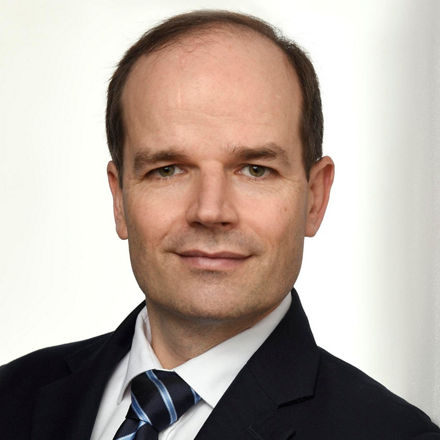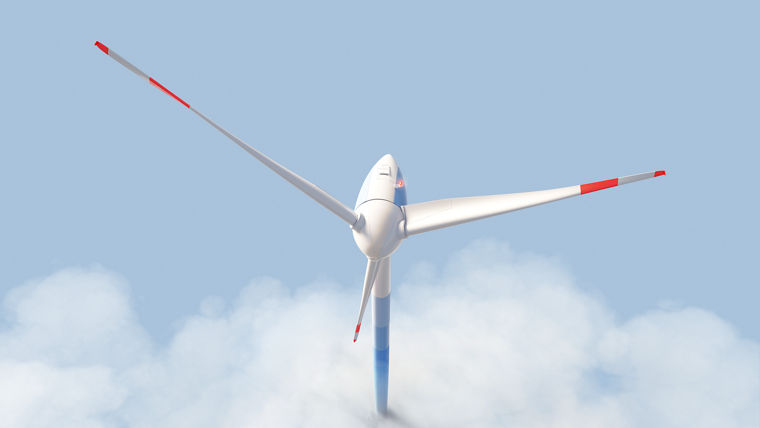“Cold Hawaii” is the name that wind surfers have given the 55-kilometer stretch of coast in northern Denmark that extends from Hanstholm in the north to Agger in the south. Here, in the Thy National Park, there is a steady and strong westerly wind that the surfers love. Thirty kilometers farther east is a hotspot for wind fans of a very different kind. At the test center in Østerild, seven huge wind turbines are being tested for their offshore use. The biggest of them, a model from Siemens Gamesa, is exactly 271.40 meters tall. As a result, it has replaced the 254-meter-high Storebælt Bridge as Denmark’s tallest structure. Since November, the turbine has been undergoing preparations for its commercial use, which is scheduled to begin in 2024.

»We’ve managed to launch a green rotor blade on the market«
Martin Gerhardt HEAD OF OFFSHORE WIND PRODUCT MANAGEMENT AT SIEMENS GAMESA
Each of the record turbine’s three rotors is 108 meters long and covers a surface of 39,000 square meters with each sweep. That’s almost the size of six soccer fields. “The larger a rotor and its sweep, the more clean energy the turbine generates,” says Martin Gerhardt, the head of Offshore Wind Product Management at Siemens Gamesa. However, this record won’t last long. The world’s four largest offshore wind turbine companies—besides the German-Spanish company Siemens Gamesa, they are Vestas from Denmark, GE Renewable Energy from the USA, and Mingyang Smart Energy from China—are competing intensely with one another to erect the most powerful turbine. The winner is definitely the environment. Together with photovoltaic systems and hydropower plants, wind turbines contribute considerably to the global energy transition.
The performance data of the current turbines was still unthinkable a few years ago. For example, the wind turbine from Siemens Gamesa in Østerild has a capacity of 14 megawatts and can even achieve a peak performance of 15 MW. Vestas wants to present a model this year that will supply 15 megawatts in continuous operation. However, a lot of wind is needed to drive the huge rotors and this wind is mainly available on the high seas. “We have to make offshore wind power the backbone of decarbonization,” says Gerhardt.
However, this is by no means easy. The turbines’ great weight and the enormous centrifugal forces, as well as the rough conditions on the high seas, pose huge challenges for the structure and the materials. Moreover, offshore facilities have to be especially robust. Offshore repairs are complicated and very expensive; it’s best if the giants operate maintenance-free.

Such demands can only be met with well-founded research. “The rotor blades, for example, are becoming bigger and bigger,” says Christian Schmidt, who heads the Crosslinkers business line at Evonik. “That poses new challenges, not only during transport and construction but also earlier on, during production. We’ve developed customized products to deal with this.”

Rotor blades are now technological high-performance products made of a variety of materials. Most of them are made in two half-shells. Each half of a blade is made of fiberglass mats impregnated with VESTAMIN® IPD. This resin provides the rotor blades with the required mechanical stability and ensures that the finished turbines have a long service life. The composite structure’s service life can be extended further by applying silicon dioxide particles directly to the mats or mixing them into the impregnating resin. These particles are called NANOPOX® and were developed by Evonik. If 2,500 were piled on top of one another, they would be as thick as a human hair. The reinforced blade halves are connected to one another by carbon-fiber bars. This produces hollow spaces, which are then filled with foam. Weight is the most crucial aspect here. Evonik has developed the structural foam ROHACRYL™, which requires minimal amounts of resin and has a low density that enables it to be customized to meet the wind turbine industry’s requirements and thus make weight-saving designs possible.
Good adhesion – but slow
Huge amounts of adhesives are needed for the gigantic rotors. After all, the full length of both halves has to be glued together. This can be a technological challenge, given that the blades are up to 200 meters long. “In the past, the adhesive that was applied first would already have hardened while glue was still being applied to the other end of the blade,” says Schmidt. “We solve this problem by using a special Ancamine that prolongs the gel phase, during which the adhesive hasn’t hardened yet.” This is extremely important for durability. That’s because the adhesive doesn’t just hold the two halves together, but also fills the production-related cracks and fissures and hermetically seals the rotor.
ELEMENTS-Newsletter
Get exciting insights into Evonik's research and its social relevance – conveniently delivered to your inbox.
SWEEPING THROUGH THE AIR AT 400 KM/H
The last thing to be applied is the coating. Storms, hail, sand, and airborne salt—the rotors especially have to be protected against these extreme influences. To do this, many manufacturers use coatings that contain fumed silica from Evonik. This silica ensures that the protective coat can be applied to the blades with uniform thickness. In addition, it contains special crosslinkers that accelerate the drying of the coatings and make them more resistant to the effects of weather.
A blade’s corners and edges are especially critical. The leading edge sweeps through the air at speeds of up to 400 kilometers per hour. A foam-like protective coating consisting of polyurethane is therefore applied to this edge. Additives from Evonik’s toolkit ensure that this coating has the right structure. Without these protective coating, the rotor blades would be damaged in no time.
Higher, bigger, stronger
From 1990 to 2024 – how the performance data of modern wind turbines has developed.

However, even careful and technologically demanding manufacturing processes cannot prevent the rotors from experiencing extreme strain. For example, a gust of wind during a storm can make a more than 100-meter-long rotor blade bend by several meters. This occurs over and over again during the many years in which the turbine is in use. “It would be the beginning of the end for a rotor if the bending of the blades caused the protective coating to crack,” says Schmidt. “Our special crosslinker called VESTANAT® IPDI is used in many coatings and gives the resins both stability and flexibility.” This is the only way that the rotors can achieve the new size records, as also shown by the tests in Denmark.

FLOATING FOUNDATIONS
But that’s not the only place where the offshore giants have to work well, because wind farms are currently being built at sea all over the world. In 2021 alone, the amount of offshore wind power generated worldwide increased by more than 25 percent to a total of 130.6 terawatt-hours. The Siemens-Gamesa turbine that is currently being tested in Denmark will go into operation in the Sofia Wind Farm on Dogger Bank off the northeastern coast of the UK. Beginning in 2024, a total of 100 such turbines will be installed here, boasting a total rated capacity of 1.4 gigawatts, which is the equivalent of a nuclear power plant. Additional projects will be implemented close by on this shoal, which connects Great Britain with the European continent.
Such beneficial conditions, with water that in some parts is only 13 meters deep, are rather exceptional from a global standpoint and are primarily found in Europe and off the east coasts of North America and China. In other areas, the sea bed generally drops steeply so that the water is more than 60 meters deep only a few kilometers from shore. This depth is considered the limit at which a wind turbine can be built on a conventional foundation.
“The next big step will be to make these deeper regions accessible with floating turbines so that wind power’s potential can be exploited worldwide,” says Gerhardt.


»The size of the rotor blades
creates new production
challenges«
CHRISTIAN SCHMIDT THE HEAD OF EVONIK’S CROSSLINKERS BUSINESS LINE
The thought of floating wind turbines might sound absurd, given the height and weight of these titans. However, a variety of concepts are already being tested. One such idea is to put each wind turbine on top of a huge submerged buoy. The upper part of the buoy is filled with air in order to give it buoyancy, while the bottom contains a counterweight to the wind turbine. Such structures have been used for more than four years at a wind farm around 25 kilometers off the Scottish coast. Due to their size, they can only be assembled out on the high seas.
Elsewhere, the foundation is provided by relatively thin buoyant platforms that are attached to the seafloor by cables. However, they are unstable during assembly and the cables are subject to intense stresses. The companies Shell from the Netherlands, Tepco from Japan, RWE from Germany, and Stiesdal from Denmark recently presented a promising project in Norway. This project uses a structure called TetraSpar, which consists of the same steel elements as the wind turbine masts.
These are inexpensive to make, can be worked with existing machines, and use existing logistics paths. Underneath the floating platform is a triangular weight that is not lowered until the turbine reaches its destination, where the weight is sunk and anchored to the seabed. This makes it possible to attach the wind turbine to the platform while it’s still in port, from where the completely assembled system is then tugged to its destination. Since December, a test facility has been in operation in 200-meter-deep water off the coast of Norway.
In normal operation these steel structures will float in saltwater for several years without getting a new coating. In the coatings, an additive from Evonik serves as a barrier against the saltwater. “Unlike a ship, for example, which can be put into dry dock, the substructures of wind turbines have to stay in the water for the facility’s whole service life, which lasts for several decades,” explains Schmidt. “The coating also protects the system against mechanical strain such as that caused during assembly or when service ships are moored to the platform.”

EMERGING MARKETS BENEFIT
The new options for offshore facilities also make the use of wind power attractive for countries that until now have been unable to access renewable sources of energy. The International Energy Agency (IEA) and the International Renewable Energy Agency (IRENA) expect the amount of electricity from offshore wind turbines to increase immensely in the future. The global capacity might rise to 2,000 gigawatts by 2050, compared to slightly over 35 gigawatts at the end of 2020.
The main drivers of this development will be the rapidly growing developing countries and emerging markets, who can eliminate their dependence on imported fossil fuels and generate electricity more inexpensively than before. According to the Global Wind Energy Council (GWEC), an organization of 1,500 players from the wind energy sector in 80 countries, this could potentially have big benefits for the respective regional economies. Because wind turbines consist of very big pieces, it’s not economical to transport them over long distances. The on-site assembly and subsequent maintenance create many qualified jobs.
Naturally, the big economic powers have also recognized this sign of the times. In the United States, the Biden administration announced a program in October 2021 for the massive expansion of offshore wind power. The turbines will supply green energy for ten million households and create 77,000 new jobs in the wind energy sector.
The aim is to create a total of seven huge offshore wind farms in the Gulf of Mexico and along the US East and West Coasts in order to supply economic centers in the coastal areas with electricity. “We’re at a turning point for domestic offshore wind energy development,” US Interior Secretary Deb Haaland said. “We must seize this moment.”


»Wind energy will have a dynamic impact on the US economy«
BONNIE TULLY EVONIK NORTH AMERICA
These goals are considered ambitious. “Offshore wind power in the western hemisphere has never seen anything like this,” said Mike Jacobs, senior energy analyst at the Union of Concerned Scientists. To date, the USA has only seven offshore wind turbines—five in a wind farm off Rhode Island and two more set up as tests in Virginia. Bonnie Tully, who manages Evonik’s business activities in the USA, now expects the program to provide the world’s biggest economy with a substantial boost. “Wind energy will have pretty dynamic effects. It helps to keep costs low in supply chains, production, and the construction sector.”
BOOM IN CHINA
China, the world’s second-largest economy, has been using wind power for some time, and its installed capacity is twice as large as that of the USA. Moreover, the People’s Republic of China has been achieving new expansion records year after year. The Bloomberg news agency has calculated that China added around 58 gigawatts to its wind power capacity in 2020 alone. That’s more than half of the facilities that were put into operation worldwide in that year. The country’s wind energy sector is correspondingly important, and seven of the world’s top ten wind turbine manufacturers are from China.
Evonik responded to this growth early on and opened an isophorone diamine plant in Shanghai in 2014. The company has extensive experience with isophorone chemistry, which has been in use for 60 years and serves as the main technological basis for preventing materials in wind turbines from becoming brittle or fragile. Today Evonik manufactures isophorone products on three continents. In addition to the facility in Shanghai, these products are also manufactured in Marl and Herne (Germany), Antwerp (Belgium), and Evonik’s biggest US location, in Mobile, Alabama. Recently the company also began to make these products from renewable raw materials. Evonik has developed a procedure for turning such materials into the precursor product acetone. This is part of Evonik’s “eliminate CO₂” mass balance approach, which aims to substitute fossil carbon with renewable or recycled carbon.
REINFORCING, BONDING, PROTECTING
Cross-section of a wind turbine rotor showing where which Evonik product is used in the turbine blade.

Iris Zhen, who manages Evonik’s crosslinker business for China and Southeast Asia from the location in Shanghai, expects further growth. “China wants to become carbon-neutral by 2060. The first step toward achieving this goal is to generate a large part of the electricity from emission-free and renewable sources and thus accomplish the transition to sustainable and clean energy sources and a carbon-free economy.” Zhen also thinks that wind will play a crucial role in a clean energy future, and she expects “Asia, and China in particular, to continue to dominate the global wind energy sector.”
GIVING ROTORS A NEW LEASE ON LIFE
There’s no doubt that the carbon-free electricity from wind power benefits the environment. But how durable are wind turbines and how are they disposed of? “Our wind turbines are designed to last at least 25 years,” says Gerhardt. A turbine’s service life is mainly determined by its rotor blades. “We have made progress here with new concepts and materials that have considerably improved durability under the harsh offshore conditions.” The recycling of steel, concrete, and metal is already no problem, adds Gerhardt. However, the recycling of the rotor blades is more difficult. The rotors consist of a mixture of plastic and carbon fibers as well as of balsa wood. These materials can be separated from one another only with great difficulty. “However, we recently launched a truly green rotor blade on the market for offshore use: the RecycableBlade,” says Gerhardt.
Creavis, the strategic innovation unit at Evonik, has the same aim and is now pooling the expertise from a variety of business lines in order to make wind power a part of the circular economy. The structural foam ROHACRYL™ is already reusable. As a result, Martin Gerhardt’s plans for the future might become a reality. “Our goal for 2040 is to build only turbines that are fully recyclable,” he says. Once that goal is achieved, it won’t just be the huge rotors that will go in circles for as long as possible, but also the materials that they are made of.


